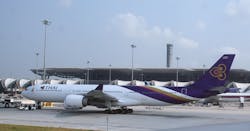Suvarnabhumi Expands, But Still Struggles With Baggage Basics
Sitting at our desks on the other side of the world, it’s hard to comprehend everything we’ve read about Thailand’s six-year-old international gateway, Suvarnabhumi Airport, located about 16 miles from Bangkok.
From 200 armed thugs taking over a parking lot for an afternoon to demonstrators occupying the terminal for days. From sinkholes in the runways to an outage in BKK’s otherwise uninterruptible power supply that knocked out radar.
We’ve read so much about BKK that we wonder if each and every one of the airport’s problems could be true.
But we don’t doubt the truth behind the airport’s expansion plans. Last year, 48 million travelers passed through BKK, and the number is likely to reach more than 52 million this year. The problem is BKK was designed to handle 45 million annually and passed that threshold years ago.
“We are, consequently, planning to expand our passenger capacity to 60 million.”
says Toompetch Boonyaridh, vice president of corporate communications for Airports of Thailand Public Company Ltd., the airport authority for BKK and five other Thai airports.
As a result, AOT is speeding up completion of BKK’s expansion by one year with Phase 2 scheduled for completion in 2016.
Under the Phase 2, a satellite terminal will be built with 28 gates, eight of which will be able to handle the A380. The new and current terminal will be linked by an underground tunnel almost a half-mile long, which will come with a people mover. The expansion also includes more the 10 million square feet of new apron for aircraft parking.
As Boonyaridh notes above that will raise BKK’s passenger capacity to 60 million a year. The problem is the accelerated construction plan will just catch up with projected traffic demand by 2016.
As a result, BKK will need to carry out Phase 3 as soon as Phase 2 ends. Phase 3 calls for the construction of another passenger terminal, a runway and the expansion of the main passenger terminal. Work under Phase 3 would render an incremental capacity of 13 million passengers a year, allowing BKK to cope with the demand until 2022.
BAGGAGE DELAYS
All good and well, but the airport is also currently addressing problems with baggage handling. Neither of the airport’s two main ground support companies can meet the set time limit for delivering baggage.
Thai Ground Services, a part of the Thai Airways brand, could meet the mark only a third of the time. That’s particularly alarming since Thai Ground Services handles about three-quarters of the bags at BKK.
Bangkok Flight Services, a joint venture between Worldwide Flight Services and Bangkok Airways, handles most of the rest of the load and did better, but still met the set time limit 63 percent of the time.
According to Somchai Sawasdeepon, director of Suvarnabhumi Airport, guidelines call for the first bags to appear in baggage claim no more than 20 minutes after deplanement with the last bag to appear within a half hour.
“I’m afraid the problems persist despite numerous warnings and they have yet to get their acts together,” Sawasdeepon told the Bangkok Post last July. He blamed delays on insufficient manpower and equipment rather than any glitches with airport’s baggage system.
We reached out to both ground handlers for their comments and heard from one.
“The issue with the baggage handling is mainly directed at TG and AOT have met with them two weeks ago to get their commitment to improve the service,” Robert Ruesz, director of passenger services and sales, BFS, told us by email. “We are working with the Airport Baggage Committee identifying infrastructure and other issues that are challenges at such a large, single terminal airport.”
He added that the company rarely receives any complaints from its customers since he believes BFS operates well compared with airports of a similar size.
“However, we are always looking for improvement and have suggested some areas that could reduce delivery times,” he adds. “These are ongoing discussions with the airport authority.”
With the expansion of BKK years away, AOT is taking other action to ease congestion at the airport.
Last March, for example, the government ordered all low-cost carriers to move to Don Mueang International Airport – once the country’s premier gateway that was originally closed the day BKK opened.
Some 10 LCC began moving to the airport’s single runway as of Oct. 1. These include some LCCs that might be light on price, but are heavy on passengers. Thai AirAsia, for example, carried 7.2 million passengers in 2011. Of course, that amounts to half the total capacity for Terminal 1, but DMK has two other terminals and AOT has plans are to renovate all three terminals.
AOT expects Bangkok's LCC traffic, which didn’t exist eight years ago, will rise at an annual rate of 20 percent for the foreseeable future.
While the government order to move LCC traffic to DMK began Oct. 1, it isn’t scheduled to conclude until next summer. In the meantime, the fast pace to hire two ground handlers for DMK has many asking questions about the process. Bidders complained that the process gave them three business days to prepare bids and that the period of time granted to the winning bidders was for three years instead of the usual five years that AOT typically grants.
Thailand’s Traffic Continues To Grow
Airports of Thailand Public Company Limited also have plans for one other airport.
Phuket International Airport will get a new taxiway and aircraft parking bay, as well as a new international passenger terminal to accommodate an additional 5 million passengers. The AOT is also renovating the existing domestic passenger terminal to accommodate 7.5 million passengers annually. AOT is working on other facilities at HKT, including an aircraft fueling pipeline.
When the improvements are completed, HKT will be able to handle 12.5 million passengers annually.
Tourism has made HKT the country’s second busiest airport. But much of the growth will come at the country’s current busiest airport and its one-time busiest airport.
Passengers passing through Suvarnabhumi Airport and Don Mueang International Airport are expected to soar from 69.5 million in 2017, to 84.7 million in 2022 before reaching 102 million in 2027, according to long-term projections from the International Civil Aviation Organization and International Air Transport Association
Suvarnabhumi Airport
BKK currently handles around 830 flights operated by 100 international carriers with some 150,000 passengers passing through each day.
In 2011, commercial airline movements totaled 288,540 flights or a 10 percent increase over 2010. The vast majority of this growth was from international flights.
The number of passengers totaled 47.8 million or a 12 percent increase over 2011.
Don Mueang International Airport
DMK only accommodated two domestics scheduled airlines in 2011, but business will pick up considerably as more low-cost carriers move operations from BKK to DMK.
However, it’s easy to see the growth in low-cost carrier operations to Bangkok from DMK’s statistics. The number of commercial flights in 2011 totaled 47,508 flights or an increase of 41 percent over 2010.
The number of passengers totaled 3.9 million or a 44 percent increase.
About the Author

Manik Mehta
Manik Mehta is a New York-based journalist, who specializes in all the aspects of aviation and logistics, including airlines, aircraft leasing, airports, infrastructure, cargo and ground-handling, as well as global markets, trade and business.
